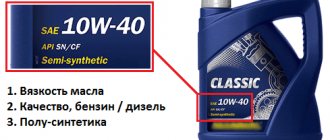Mazda SkyActiv technologies: The sky is higher
Mazda has delayed the appearance of its own compact crossover - competitors have already released the second or third generation in this segment. The Japanese remained silent for a long time in response to direct questions about the potential CX-5. And for good reason: the CX-5 will not just be a new model, but the starting point of Mazda's new SkyActiv technologies. This is a new concept for Mazda, covering engines, transmissions, chassis and bodywork. A concept that seeks to combine dynamic, emotional driving and efficiency, while remaining accessible to the masses. Mazda explained how it will work and be sold at a technical seminar. The meeting place is the Great Moscow Planetarium, which opened after 17 years of reconstruction. Of course, the place was chosen with meaning: SkyActiv’s slogan is “Only the sky is higher” (in English it sounds more cautious: Sky is the limit).
It is necessary to move on. But if most companies are leaning towards hybrid technologies or electric vehicles, which still raise doubts about their viability (production costs, infrastructure development, cost to the end consumer, etc.), the small but proud company Mazda decided to go for own path and took up classic internal combustion engines.
Motors
Fuel consumption and CO2 emissions are the main reasons for the insomnia of modern automotive engineers. And not least of all the Mazda ones: it’s no secret that a number of Mazda models, especially those with automatic transmissions, are distinguished by their uneconomical appetite.
The average internal combustion engine has an efficiency factor of 35%. The losses are mostly of a thermal nature and depend on the exhaust system, cooling, engine housing elements and gearboxes. The operating efficiency is affected by the composition of the working mixture, combustion duration, valve timing, suction losses, mechanical friction losses and compression ratio. It is these six parameters that Mazda engineers focused on in their pursuit of the ideal engine.
The main parameter is the compression ratio. The compression ratio for gasoline engines ranges from 9.0 to 11.0, while for Mazda cars the average is 11.0. In sports cars, the compression ratio reaches 12.5. Obviously, as the compression ratio increases, the thermodynamic efficiency increases, but this can lead to abnormal combustion (detonation) and, as a result, a decrease in torque. A richer mixture and delayed ignition are used to suppress detonation, but this results in poor fuel economy and reduced torque.
SkyActiv-G petrol engine
The SkyActiv-G petrol engine has a compression ratio of 14.0:1. To avoid detonation, Mazda engineers developed a special exhaust manifold with a 4-2-1 design - the exhaust flows through long downpipes and is cooled better, which prevents exhaust gases from returning to the combustion chamber, which leads to lower pressure and suppressed detonation.
EASY IN BATTLE
Mazdas with Skyactiv petrol engines have been running around Russia for almost three years. And so far, oddly enough, without serious problems. At first, there were several cases of replacing oil pumps, which for some reason did not develop maximum performance, which is why the hydraulic variable-phase coupling on the exhaust shaft was primarily acting up.
Then the story of “double starts” happened, which we talked about in detail (ZR, 2013, No. 8). And now there have been several cases of wear on the intake camshaft cams, leading to an increase in engine noise. But everything described can be safely attributed to exceptions to the rule, which also confirm it: Skyactiv motors are quite reliable.
There are no serious statistics regarding turbodiesels yet: they have been on sale for just over a year, and the demand is extremely low. I can only assume that there won’t be many problems with them either, since the loads are significantly reduced. The 2.5-liter Skyactiv-G petrol does not cause concern either, since its compression ratio has been reduced to 13.
DIESEL EFFECT
The compression ratio affects a very important parameter in the operation of a diesel engine - the auto-ignition delay. After injection, the fuel needs a certain time to atomize and mix with air. For high efficiency, it is important that the mixture begins to burn as close as possible to the top dead center of the piston (TDC). That is, the injection must be done in advance. Then all the expansion energy of gases during combustion will have time to move the piston down.
In engines with high coolant, the pressure and temperature at TDC are very high. Early injection causes the mixture to ignite spontaneously before it is mixed. This results in uneven, “noisy” combustion with increased emissions and back pressure against the upward movement of the piston. Therefore, in such units injection is done later. As a result, combustion occurs after passing TDC, when the piston itself goes down, and part of the thermal energy is wasted.
The Skyactiv-D turbodiesel with low coolant has a correspondingly lower pressure and temperature. This allows for earlier injection. Combustion of the mixture takes longer and is more efficient even close to TDC. The result is higher efficiency and environmental friendliness of the motor.
Thank you for your help in preparing the material from those (18th km of the Moscow Ring Road).
Skyactiv engines: rebuild
Long test drive: Mazda6 Skyactiv 2.5 Turbo Executive Plus
TEXT DMITRY SOKOLOV
The current Mazda6 first arrived in our garage 4 years ago. From the very beginning, it had its trump cards: undeniable beauty, an excellent chassis with excellent grip even on snow (despite its impressive size for a front-wheel drive car), luxurious active headlights and a decent amount of space in the rear. With a caveat, of course: we close our eyes to the distance from the rear sofa cushion to the roof, but here, see point one.
However, now we are driving a car that has been radically redesigned. The changes are more than solid in everything except beauty. They only added a little maturity to her in accordance with her age and status, but overall they did not change anything. It would be simply sinful: Mazda6 was drawn in classical proportions, looking for the eternal in the momentary. And they found it: like the Alfa Romeo 159, the Mazda6 does not age. She has been on the market for eight years now, but does not look one iota behind the times.
During this time, the market, politics and the economy have gone through so many epoch-making disruptions and restructurings that technology could not be left unchanged: what worked in 2012, today not only does not work, but in many ways does not exist. Large mid-priced sedans have largely given way to crossovers, the supply of which is extremely wide, and buyers who want a larger three-box (but at a lower price) find their happiness in other car dealerships. Mazda6 has become the choice of those who are willing to pay extra for fun, elegance and class. And the car got exactly what it needed.
The premium effect is half sounds. The sounds of everything - from the doors slamming to the noise (or rather, the lack thereof) that increases with speed and as the character of the asphalt changes. Now the floor and windshield are thicker, sound insulation has come to the wheel arches and trunk. The body itself has also become stiffer, new mats have been laid underneath and on the tunnel, the linings of the pillars and ceiling have been redesigned, sound-absorbing side windows have been used, the aerodynamics have been corrected - all this was done for the sake of the result, not for show. That’s why a rich, expensive silence now reigns in the salon. No itching, no noise, no whistling wind. Peace of mind for every day: closed the door, cut off the noise and bustle, and thoughts went in a completely different direction.
A wide suede shelf under the dashboard, a climate control adjustment unit recessed into the trim, and a multimedia control washer changed the appearance of the interior. It consists entirely of “physical” and pleasant controls and puts you in a completely different mood than solid glass with clusters of fingerprints. We, people who are already adults, still like things that are pleasant to hold in our hands, feeling the class of the material, and not just imagining it from an animated picture. The only thing that today no longer meets modern ideas is the image from the front and rear cameras. Their low location makes the distance to the obstacle not at all as obvious as we would like. There is room for the legs in the back, less room for the head, and among the pleasures, in addition to the surrounding high-quality design, there is a heated sofa and cup holders in the armrest.
Previously, the Mazda6 was weaker, but sportier and tougher. Almost all elements of the suspension have been changed, except for levers and knuckles, from rubber bands to shock absorbers. The chassis no longer encourages you to “steer” with or without reason. It's the feeling of driving a big, expensive car that does everything right and is balanced for stability rather than fuss. The suspension has learned to handle irregularities so that they are delivered to passengers in a clean form - without sharp corners and teeth grinding. Plus a powerful turbo engine of 2.5-231 horsepower, perfectly responsive to the pedal, with a quiet but tasty rumble and powerful torque from the very bottom. He brings everything that we mean by the concept of “premium” to a complete set.
_______________________________________________________
- Standard / test price: 2,323,000 / 2,470,000 rubles
- Engine: 2488 cm³, turbo, 231 hp, 420 Nm.
- Transmission: front-wheel drive, automatic
- Dynamics: 0-100 km/h in 7.0 s, 239 km/h
- Consumption: 5.9-10.7 l/100 km
- Weight: 1578 kg
_______________________________________________________
- KAYFOVO
Design, premium feeling, power reserve and ease of traction control, light
- SAD
The location of the rear and front cameras: bad angle, quick contamination
_______________________________________________________
- Our mileage: 1350 km
- Our consumption: 12.3 l /100 km
Mazda Skyactiv engine life and problems
Mazda engineers have created economical and at the same time productive power units, while the engines comply with the EURO-6 standard. Another feature of the petrol version of Skyactiv is that the engine remains naturally aspirated.
In practice, this means that during operation typical problems that are usually characteristic of supercharged gasoline engines should not arise. However, to achieve such outstanding performance, Mazda’s naturally aspirated engine still turned out to be complex in design.
As for the diesel version, lowering the compression ratio to 14, on the contrary, indicates a reduction in the load on the diesel engine. In this case, the engine has also become more complex, but it is quite possible to count on a fairly long service life of the main elements of the CPG and the crankshaft.
Let's return to statistics and practical operation. Skyactiv gasoline engines appeared in the CIS about 5 years ago. If we look at Skyactive engines, problems arise with them, but so far the recording of problems with these internal combustion engines has not revealed widespread and global breakdowns.
In other words, if we consider Mazda Skyactiv engines, the faults of such units that are recorded are the following:
- There have been cases when it was necessary to change an oil pump that malfunctioned and did not reach maximum performance, as a result of which the hydraulic phase change clutch installed on the exhaust camshaft began to malfunction.
- A situation was also noted when the SkyActiv engine, after starting the first time, stalled after a short period of time. For normal operation, the unit had to be restarted 2-3 times, after which the motor worked stably. Probably the problem was not “mechanical”, but related to the ECU firmware, since European versions with this engine worked without such failures.
- It should also be noted that on some SkyActive engines wear of the intake camshaft cams occurs, as a result of which the engine operates noisier.
Although the manufacturer himself voices a resource figure of about 300 thousand km, this calculation assumes ideal operating conditions, high-quality fuel and engine oil. This means that up to 100-150 thousand km. problems with the engine may not arise, but then a complex unit may well turn out to be extremely expensive to repair or even unrepairable. It is also noted that closer to 100 thousand, coils and ion sensors fail. On vehicles where fuel is not of the best quality, the fuel injection pump, as well as the injectors themselves, may require attention.











